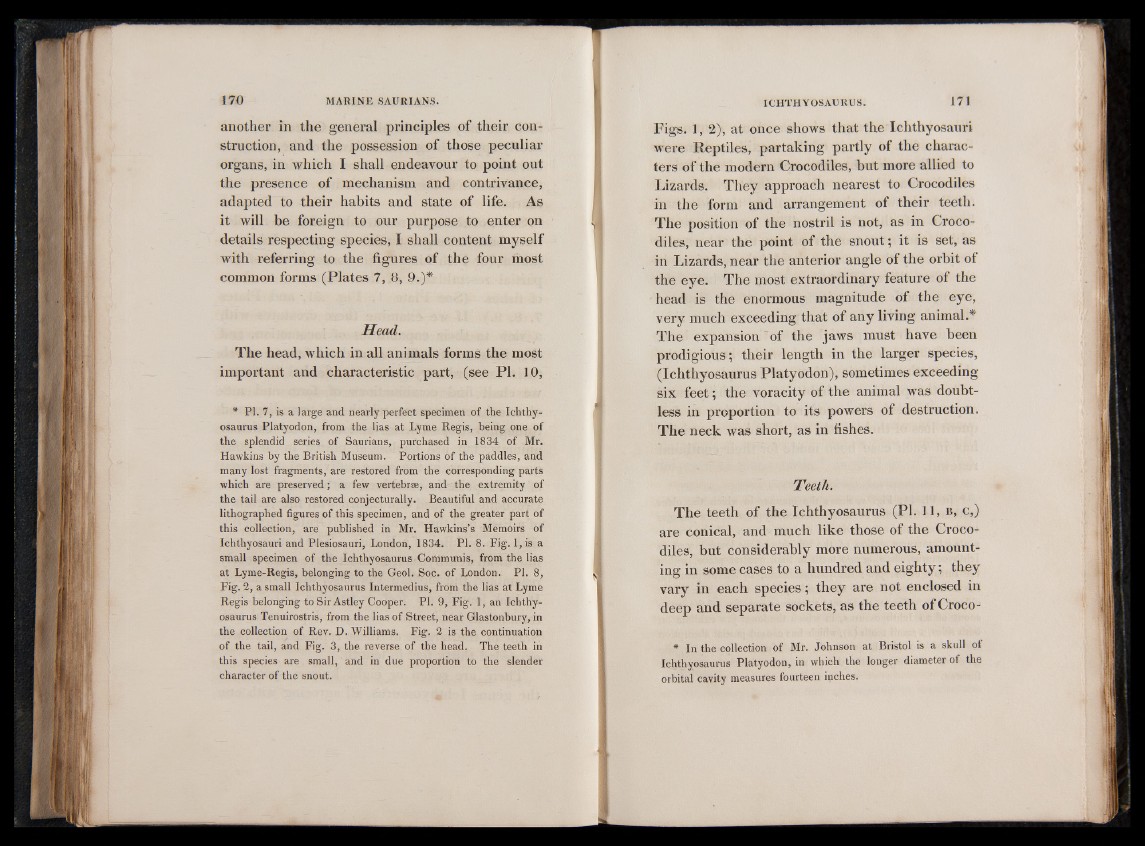
another in the general principles of their construction,
and the possession of those peculiar
organs, in which I shall endeavour to point out
the presence of mechanism and contrivance,
adapted to their habits and state of life. As
it will be foreign to our purpose to enter on
details respecting species, I shall content myself
with referring to the figures of the four most
common forms (Plates 7, 8, 9.)*
Head.
The head, which in all animals forms the most
important and characteristic part, (see PI. 10,
* PI. 7, is a large and nearly perfect specimen of the Ichthyosaurus
Platyodon, from the lias at Lyme Regis, being one of
the splendid series of Saurians, purchased in 1834 of Mr.
Hawkins by the British Museum. Portions of the paddles, and
many lost fragments, are restored from the corresponding parts
which are preserved; a few vertebrae, and the extremity of
the tail are also restored conjecturally. Beautiful and accurate
lithographed figures of this specimen, and of the greater part of
this collection, are published in Mr. Hawkins’s Memoirs of
Ichthyosauri and Plesiosauri, London, 1834. PL 8. Fig. 1, is a
small specimen of the Ichthyosaurus Communis, from the lias
at Lyme-Regis, belonging to the Geol. Soc. of London. PI. 8,
Fig. 2, a small Ichthyosaurus Intermedius, from the lias at Lyme
Regis belonging to Sir Astley Cooper. PI. 9, Fig. 1, an Ichthyosaurus
Tenuirostris, from the lias of Street, near Glastonbury, in
the collection of Rev. D. Williams. Fig. 2 is the continuation
of the tail, and Fig. 3, the reverse of the head. The teeth in
this species are small, and in due proportion to the slender
character of the snout.
Figs. 1, 2), at once shows that the Ichthyosauri
were Reptiles, partaking partly of the characters
of the modern Crocodiles, but more allied to
Lizards. They approach nearest to Crocodiles
in the form and arrangement of their teeth.
The position of the nostril is not, as in Crocodiles,
near the point of the snout ; it is set, as
in Lizards, near the anterior angle of the orbit of
the eye. The most extraordinary feature of the
head is the enormous magnitude of the eye,
very much exceeding that of any living animal.*
The expansion ~of the jaws must have been
prodigious; their length in the larger species,
(Ichthyosaurus Platyodon), sometimes exceeding
six feet ; the voracity of the animal was doubtless
in proportion to its powers of destruction.
The neck was short, as in fishes.
'Teeth.
The teeth of the Ichthyosaurus (PI. 11, b, c,)
are conical, and much like those of the Crocodiles,
but considerably more numerous, amounting
in some cases to a hundred and eighty; they
vary in each species; they are not enclosed in
deep and separate sockets, as the teeth ofCroco-
* In the collection of Mr. Johnson at Bristol is a skull of
Ichthyosaurus Platyodon, in which the longer diameter of the
orbital cavity measures fourteen inches.